A closely connected and globalized world can sometimes bring benefits to a local ecosystem, but it also brings much harm. One of the worst phenomena is the spread of invasive species. According to the US Department of Agriculture, an invasive species can be defined in two major ways: it is alien or non-native to the ecosystem it occupies, and it also causes significant damage to the local ecosystem.
Some invasive animals are spread intentionally (for example, in an attempt to control other pests) and some are spread entirely by accident. Climate change is also encouraging the spread of species into new habitats. The list will cover the top 10 worst invasive species in the United States. Each animal will be judged by the extent of its spread and the damage it’s done.
#10: Asian Giant Hornet

©iStock.com/kororokerokero
Originating from eastern Russia, China, Korea, and Southern Asia, this species is also known as the “murder hornet.” While the name might be a slight exaggeration, the hornet is responsible for killing dozens of people every year; they tend to sting multiple times with their highly toxic venom. Their effect on the local ecosystem is also quite destructive and bad: they are responsible for displacing and wiping out other bee and wasp hives.
The giant hornet can be identified by its size alone: it’s the largest hornet species in the world. The first known North American sightings occurred in the state of Washington and the Canadian province of British Columbia in 2019. People are trying to stop its spread before the Asian giant hornet becomes an established species.
You can read more about the Asian giant hornet here.
#9: Burmese Python
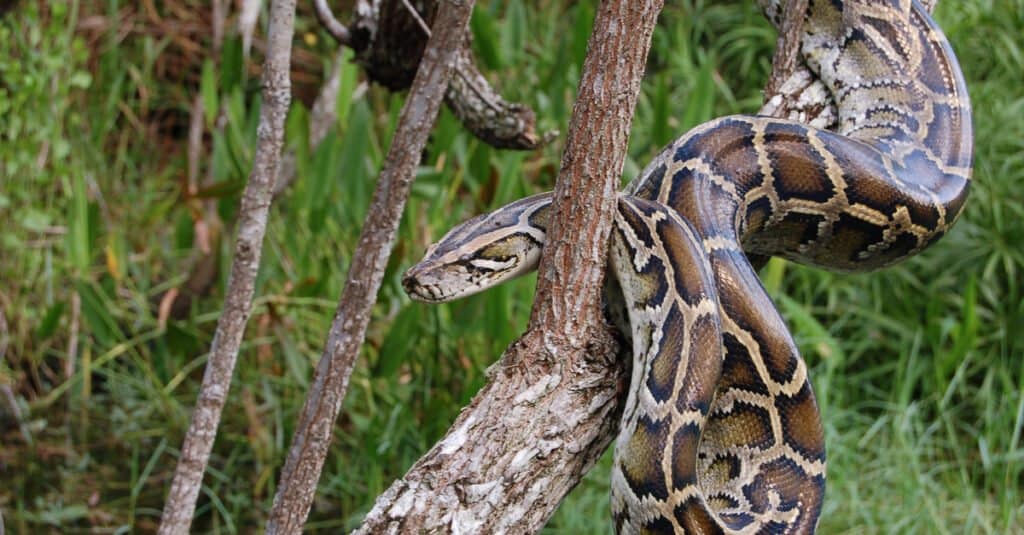
The exotic pet trade can be blamed for the invasion of the
Burmese
Python in the United States.
©Heiko Kiera/Shutterstock.com
A native of southeastern Asia, the Burmese python was imported to the United States as part of the international exotic pet trade. Irresponsible pet management, either through deliberate or accidental release, was responsible for this species escaping into the wild. Established populations were first reported around the Florida area in 2000.
Since then, it has caused significant damage to the local ecosystem by either preying directly on native species (like the highly endangered Key Largo woodrat) or competing with native species for resources (like the threatened indigo snake). Even common animals like deer, raccoons, bobcats, and rabbits have declined.
To know about other snakes that are invasive species, read here.
#8: Northern Snakehead
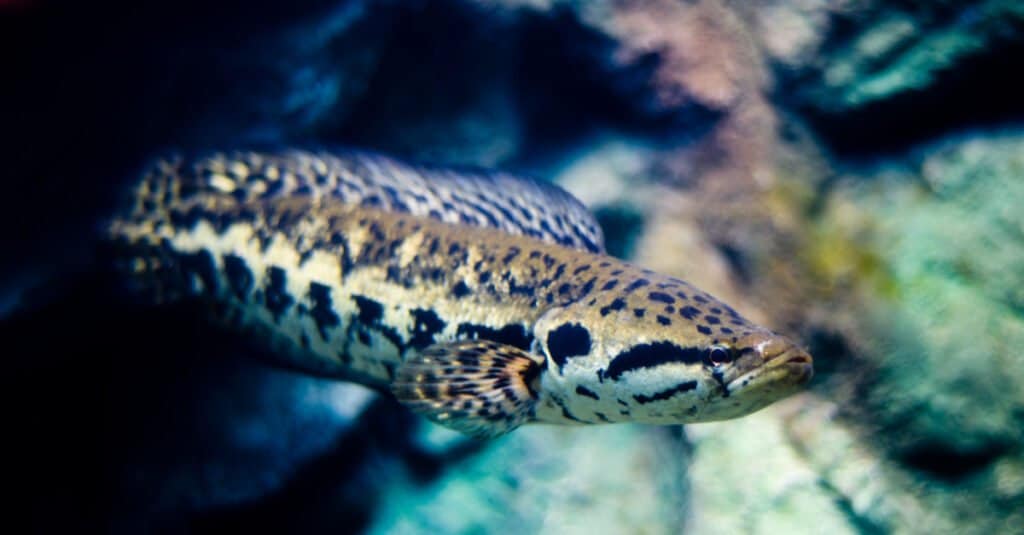
©Narongchut/Shutterstock.com
The northern snakehead is a large freshwater fish, measuring anywhere between 3 to 5 feet long, with an elongated body and a snake-like head. Originating from China, Russia, North Korea, and South Korea, this voracious species can easily double its population numbers in about 15 months by killing and consuming other local freshwater animals.
The snakehead bears a superficial resemblance to the native bowfin of North America, but the two species actually share no close relationship to each other. The snakehead can be identified by the large scales on the head, whereas the bowfin has a bony plate. Snakeheads also have a much longer anal fin and much more pronounced spots along the body.
You can read more about the differences between bowfins and snakeheads here.
#7: Spotted Lanternfly

©iStock.com/arlutz73
An adult spotted lanternfly is characterized by pink-gray forewings and red hind wings, both covered by numerous black spots and stripes. While sometimes accidentally mistaken for a moth when its wings are extended, the spotted lanternfly is actually more closely related to leafhoppers and planthoppers. It originated from parts of China, India, and Vietnam, where its primary host plant was the tree of heaven.
The lanternfly was first detected in Pennsylvania around 2014, but it may have arrived some two or three years earlier. It has the ability to damage a wide variety of different plants and crops, including maple trees, walnuts, willows, grapes, and apples. Signs of the lanternfly may include moldy or infested plants, visible damage, and oozing, or a buildup of sticky honeydew.
Quarantines are in place in several states to prevent the lanternfly from spreading on transported wood and other equipment.
You can read more about the spotted lanternfly here.
#6: European Starling
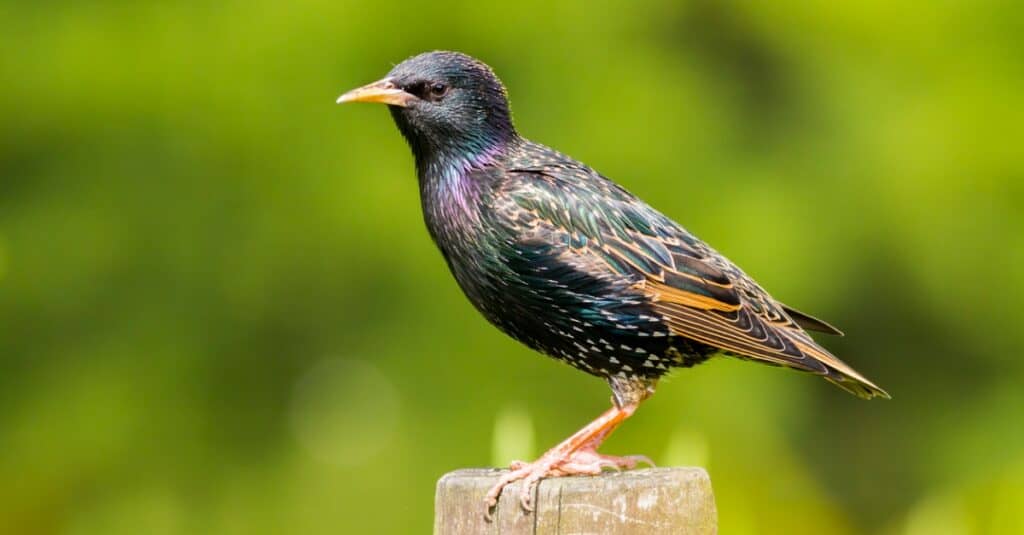
©iStock.com/chris2766
This small, unassuming bird, characterized by glossy black plumage and a metallic sheen, is in fact one of the most successful and destructive invasive animals in the world. Massive flocks of European starlings steal nesting sites from local birds, harass and take food from larger animals, and cause some $800 million worth of agricultural damage per year. This species is very common throughout Europe and migrates south for the winter.
Since being introduced into the United States in the late 19th century (one disputed story claims that Shakespeare enthusiasts were trying to release every type of bird mentioned in the bard’s works), this species has grown to a population of some 200 million. Around four million are identified as a nuisance and then killed every year by the Agricultural Department.
#5: Feral Swine
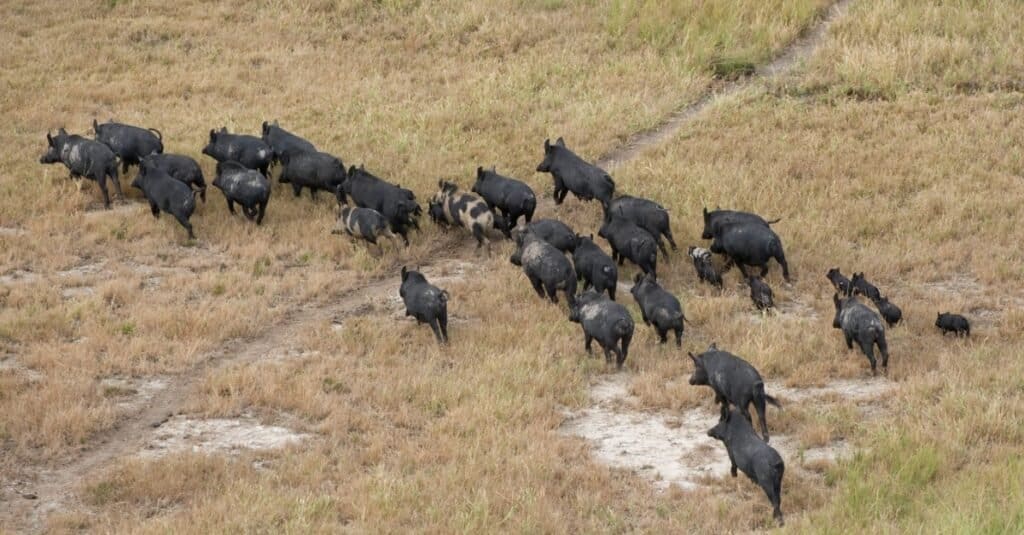
©iStock.com/JohnCarnemolla
The feral swine is not a unique species; instead, these are domesticated pigs that escaped or were released back into the wild and established a new population. It’s easy to forget that pigs are not native to the Americas. They were domesticated in Eurasia and brought over at some point in the 16th century to provide food for the colonists.
Millions of pigs farmed each year across the United States, so potential opportunities for escape are plentiful. Because of their rooting behavior, pigs can cause significant damage to crops and native flora. They can also transmit diseases, accidentally collide with vehicles, and sometimes even attack people. Some areas of the country have programs in place to hunt down feral pigs.
Feral pigs are widely considered to be the most destructive invasive species in the United States. They can do remarkable damage to the ecosystem, wrecking crops and hunting animals like birds and amphibians to near extinction
You can read more about pigs here.
#4: Asian Tiger Mosquito
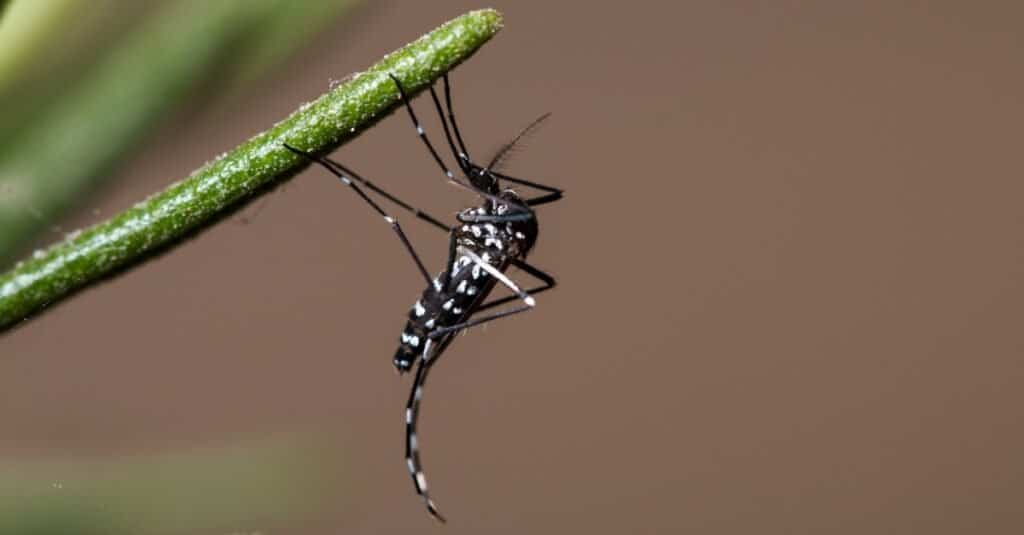
©Oliver Spiteri/Shutterstock.com
This species is characterized by its black exoskeleton with white bands around its body. While native to tropical southeastern Asia, it arrived accidentally in the United States hidden amid tire imports at some point in the late 19th century. With its ability to survive the winter by hibernating for months on end, it spread surprisingly far north, competing against and even displacing some native mosquito species.
It’s also very effective at transmitting numerous diseases, including yellow fever, dengue fever, West Nile virus, and more. Climate change could make disease transmission even worse. As cold northern parts of the country begin to warm up, the Asian tiger mosquito could become more active all year-round.
#3: Domestic Cats

©iStock.com/Photography by Adri
The cute and fluffy domestic cat may look unassuming, but in fact, it’s one of the most destructive invasive animals in the country. It has a similar historical trajectory of the feral swine: domesticated in Eurasia (from a Middle Eastern wild cat), brought over to the Americas with European settlers, and then sometimes left to roam around in the wild.
Every year domestic cats are responsible for around a billion bird deaths and six billion deaths of smaller fauna. They also transmit diseases to other animals in the wild. Keeping your cat indoors is the most effective way to stop this from occurring.
You can read more about domestic cats here.
#2: Zebra Mussel

©iStock.com/VitalisG
The zebra mussel is a small shellfish, measuring no more than 2 inches large, with a D-shaped shell that enables it to sit flat against a solid surface. Originating from the Caspian and Black Sea regions of southern Russia and Ukraine, the zebra mussel was brought to the US as a stowaway in the ballast water of ships (which provides stability and maneuvering when cargo isn’t present). It was first discovered in 1988 at Lake St. Clair and then spread to the Great Lakes, Lake Travis, and the Hudson River.
The microscopic larvae spread very quickly to colonize new areas, but they have to hitch a ride on a boat to move upstream, which makes proper quarantine efforts critical. Because of their fast reproduction rate, they can easily outproduce and compete with other freshwater creatures for natural resources like plankton.
They also have the tendency to attach themselves to native mussel species like they would a dock or boat with their root-like “byssal threads.” This prevents the other mussels from moving. Once they’re established in a new habitat, they’re almost impossible to remove.
You can read more about the zebra mussel here.
#1: Emerald Ash Borer
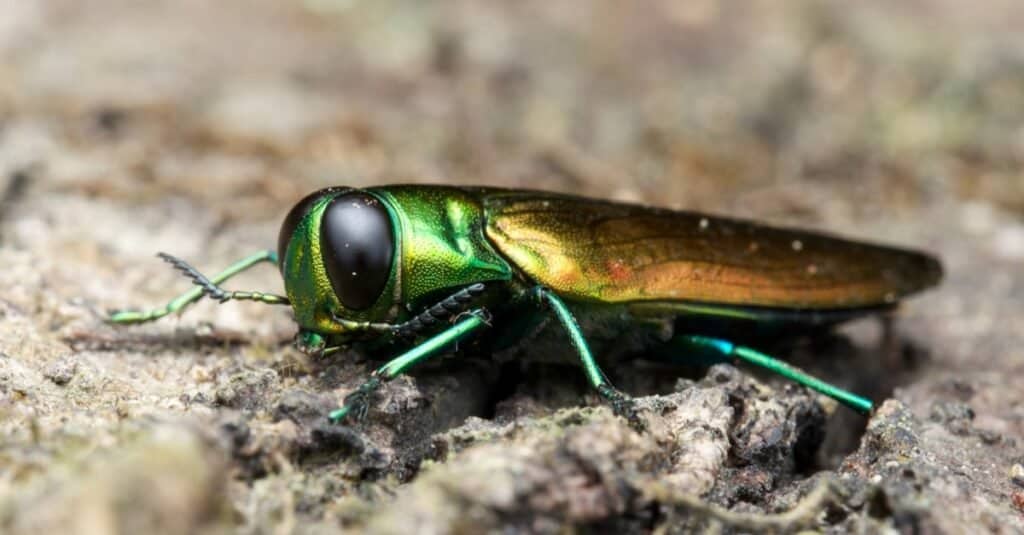
The Emerald Ash Borer, a type of beetle, kills ash trees by destroying the water and nutrient conducting tissues under the tree’s bark.
©Herman Wong HM/Shutterstock.com
Clad in a beautiful green exoskeleton, the emerald ash borer is a member of the jewel beetle family. While completely harmless in its native habitat of northeastern Asia, it has spread rapidly throughout North America and Europe, laying waste to native ash trees: perhaps tens of millions of trees across 30 states have been destroyed, and the number is growing.
It was first identified in southeastern Michigan in 2002, perhaps brought over accidentally in wood packing material. Signs of its presence include yellow, thin, or wilted foliage with D-shaped beetle exit holes. States have attempted to enforce quarantines on the transport of wood in order to stop its spread, but this has proven to be difficult. Climate change could worsen these effects.
Summary of Invasive Species in the US
| Rank | Invasive Species | Origin |
|---|---|---|
| 1 | Asian giant hornet | Originating from eastern Russia, China, Korea, and Southern Asia, |
| 2 | Burmese Python | A native of southeastern Asia |
| 3 | The Northern Snakehead | Originating from China, Russia, North Korea, and South Korea |
| 4 | Spotted Lanternfly | Originated from parts of China, India, and Vietnam |
| 5 | European Starling | This species is very common throughout Europe and migrates south for the winter |
| 6 | Feral Swine | They were domesticated in Eurasia and brought over at some point in the 16th century |
| 7 | Asian Tiger Mosquito | Native to tropical southeastern Asia, |
| 8 | Domestic cats | Domesticated in Eurasia (from a Middle Eastern wild cat), brought over to the Americas with European settlers |
| 9 | Zebra Mussel | Originating from the Caspian and Black Sea regions of southern Russia and Ukraine, |
| 10 | Emerald Ash Borer | Native habitat of northeastern Asia, it has spread rapidly throughout North America and Europe, |
The photo featured at the top of this post is © Dolores M. Harvey/Shutterstock.com
Thank you for reading! Have some feedback for us? Contact the AZ Animals editorial team.






